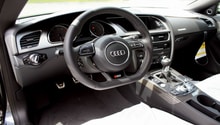Audi: Tire Problems Diagnostic Guide
Many tire problems pertaining to the Audi are easily fixable. Learn how to quickly and easily repair/diagnose common tire problems.
This article applies to the Audi Q5/Q7, A3, A4 B7, A4 B8, A6 C5, A6 C6.
You might think you're driving on a set of good tires, but the truth is without proper alignment and a long list of other requirements, the tires currently mounted on the wheels of your Audi could be a ticking time bomb waiting to explode. This is not to frighten you, but to note the importance of performing a complete inspection of your tires as soon as a problem arises. Let's go over the most likely culprits that could be causing you to experience poor tire performance.

Materials Needed
- Tire pressure gauge
- Tire tread gauge
- Replacement tires (optional)
- Brake dust cleaner
- Microfiber cloth
Step 1 – Check tires for any visible defects
They might be of a low quality.
Unfortunately, a number of Audi owners have reported concerns and issues pertaining to the original manufacturer equipment (OEM) tires (Continental) that came mounted on their wheels (direct from the factory).
- Continental tires are not highly rated among Audi owners.
- In fact, Audi OEM tires are manufactured with just one body ply.
- To offer some context, many of today's top-rated radial passenger tires come with at least two body plies.
- One downside of Audi OEM tires is that they do not come with a warranty.

Pro Tip
Replacement aftermarket tires typically range from $50 to $80 or more per tire. Some brands, however, can fetch as high as $150 to $300 for a complete set.
Step 2 – Check the alignment
Tires must be properly balanced to prevent damage and increased wear.
The easiest solution is to have your tires properly balanced by a professional mechanic.
- Many local Audi dealers and garages will balance your tires free of charge.
- If there is a fee, expect to pay somewhere between $15 and $75 (maximum).
- Also check for over or under inflation of your tires.
- If you own a tire pressure gauge, you can check the tire pressure yourself.
- As well, check for an over accumulation of brake dust on your tires and wheels. Brake dust can cause your tires to become unbalanced over time.
- Brake dust cleaners are available for approx. $20.
- Generally speaking, you should have your tires rotated and balanced every 4,000 to 6,000 miles or whenever you have a tire replaced (no exceptions).

Pro Tips
- If you have recently patched a leaky tire, it's highly recommended that you have your tires rotated and balanced. Poor alignment is the most likely culprit in such cases.
- Low tire tread depth (2/32" of remaining tread wear) can also lead to performance issues. It's highly recommended you replace tires before they become low on tread.
Step 3 – Check the tire size
They might be too large or too small.
If you're like most Audi drivers, you've probably thought about upgrading the tires on your wheels at one point or another. While there is nothing wrong with doing so, it's important to only mount tires that are the correct size to your wheels.
- Always confirm the tire size, which is stamped on the side wall of the tire, to ensure it is correct.
- Telltale signs that you are driving on the wrong size tires include, but are not limited to, decreased gas mileage, decreased top speed, and inaccurate speedometer readings.
- While checking your tires, go ahead and inspect your wheels.
- Make sure they have not been damaged, as this could lead to a decrease in tire performance.

Pro Tip
Keep in mind a cracked or damaged wheel can be welded. Talk to a automotive service professional before dumping a damaged wheel.
Step 4 – Check your load capacity
You might be exceeding it.
Going beyond your load capacity can spell bad news for your Audi.
- When towing, make sure you adhere to the maximum towing load.
- You don't want to exceed your allowable towing or carrying capacity.
- Always use properly fitted towing equipment when towing heavy loads.

Related Discussions
- Common Tire Problems Among Audi Drivers - Audiworld.com
- General Tire Troubles - Audiworld.com






